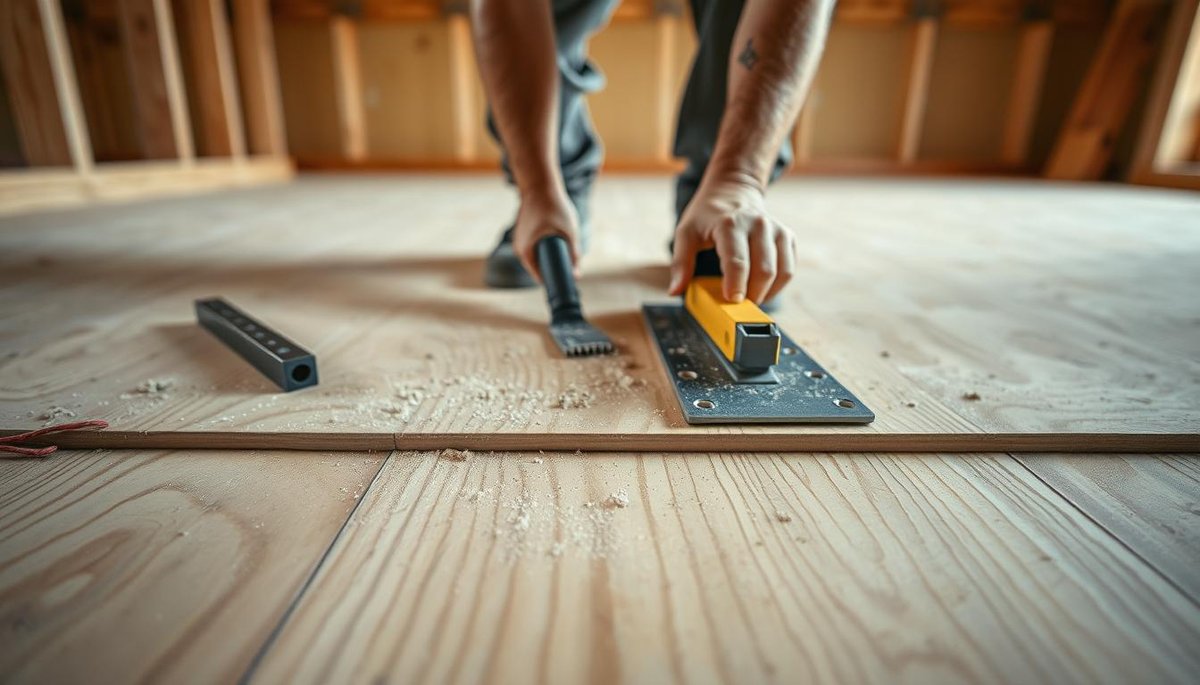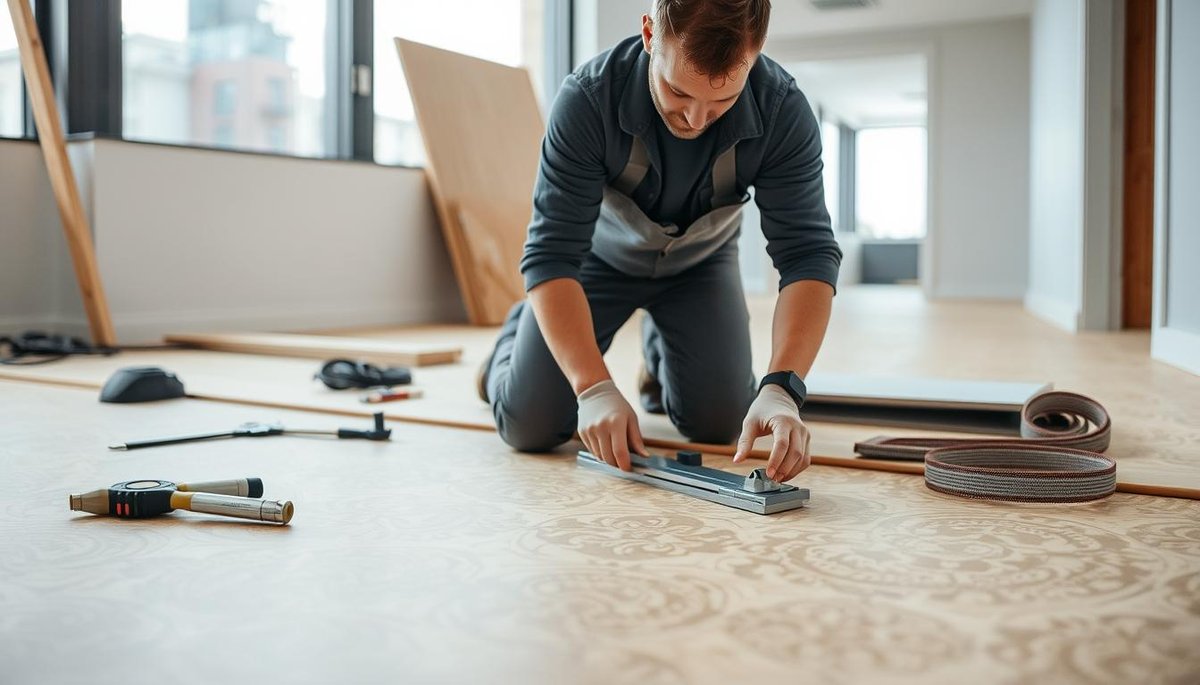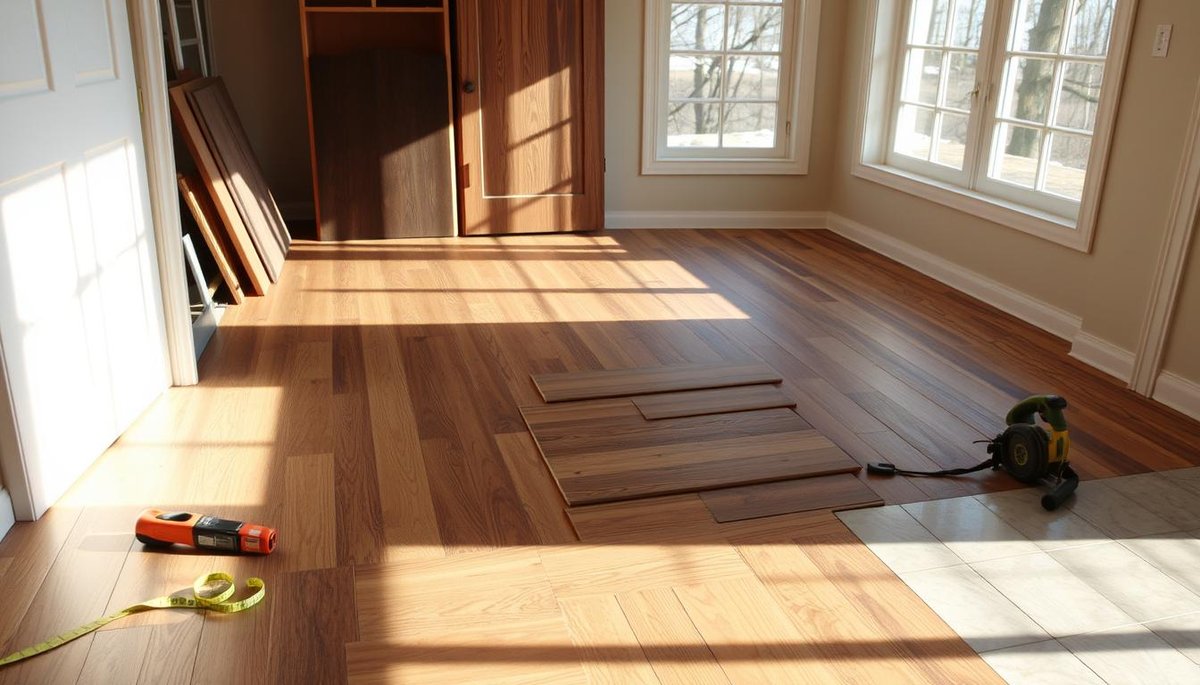How Is It Installed Over Subfloors?
Ever thought about how the floor's life span might depend on what's underneath? Knowing how to install flooring over subfloors can really change your home improvement game. The right subfloor setup is key, as it affects how well the flooring lasts and performs. This guide will explore the detailed methods and top tips for a successful first-time installation.
Key Takeaways
- The installation process requires a careful sequence to optimize the time
- Staggering the second row by 1/2 panel is critical for effective subflooring.
- Leaving an 1/8" gap around edges is necessary to accommodate possible material swelling.
- Choosing the right tools, like a long barrel glue gun, can greatly improve speed and safety during installation.
- Working together with a partner can make the subfloor installation process much faster within the adhesive's working time.
- Using the right materials, such as plywood or OSB, is important for the floor's overall quality and performance.
- Getting expert advice on managing moisture is vital to avoid problems like water damage and squeaky floors.
Understanding the Role of Subfloors in Flooring Installation
A subfloor is the layer under the finished floor, supporting hardwood, tile, laminate, and vinyl. It's key for a good flooring project. Knowing the importance of proper subflooring helps ensure a level and durable floor.
What is a Subfloor?
A subfloor is a base that holds the finished floor. It stops sagging and keeps things stable. Plywood and OSB are common, each with its own thickness and strength.
Plywood is usually 1/2 inch to 1-1/8 inches thick. OSB is rated 24/16, great for heavy use. A well-installed subfloor is essential for lasting floors.
Importance of Proper Subflooring
Proper subflooring does more than just support the floor. It also prevents moisture problems and makes floors last longer. Uneven subfloors can cause big installation problems, leading to extra costs.
Checking the subfloor often and using moisture barriers are key. They help keep the floor in good shape.
Types of Subfloors
There are many types of subfloors, each for different needs. Plywood and OSB are common in homes, making up 80% of subfloors. Concrete is better for modern and industrial places because it resists moisture.
The right subfloor affects the floor's strength, noise, and upkeep. Knowing these options helps homeowners choose wisely for their project.

Preparing the Subfloor for Installation
Getting your flooring installed right starts with a well-prepared subfloor. You need to clean and level it to make a solid base. This is key for your flooring to last long and look great. Paying close attention to these steps helps avoid problems down the line.
Cleaning and Leveling the Subfloor
Cleaning and leveling the subfloor is the first step. You must remove dust, debris, and old adhesives for better adhesion. This step can make your flooring last up to 30% longer.
When you level the subfloor, aim for a flat surface. The goal is to keep it within 3/16 of an inch over 8 to 10 feet. Using self-leveling underlayment makes the surface smooth and even. It can cut down flooring problems by up to 70%.
Moisture Testing for Subfloors
Testing for moisture in subfloors is critical. Too much moisture can cause problems like buckling and mold. It's important to keep moisture levels below 4% for both concrete and wood subfloors.
Levels above 12% can seriously damage your flooring. Using a moisture barrier when installing over concrete helps prevent moisture issues.
Repairing Damaged Subfloors
Fixing damaged subfloors is vital for a good installation. You must fix cracks and warps before installing new flooring. About 81% of flooring problems come from bad subfloor prep.
Doing a thorough check and fixing any issues is the best way to ensure your flooring stays stable and looks good for years.
Choosing the Right Flooring Material for Your Subfloor
Choosing the right flooring is key for both looks and durability. It depends on the subfloor type. You need to think about the qualities and how to install different materials like hardwood and tile.
Hardwood Flooring Options
Hardwood floors add elegance and last long, working well on plywood or OSB. They're a popular choice, making up 60% of all floors. Hardwood needs a 3/4 inch thick subfloor to avoid sagging.
Tile Flooring Considerations
Tile floors need careful subfloor choice, more so in wet places. Concrete is best for these areas. For kitchens and bathrooms, cement board underlayment keeps water out and tiles last longer. You'll need at least 1-1/4 inches of thickness for tile floors.
Luxury Vinyl Plank Versatility
Luxury vinyl plank (LVP) is very flexible, sticking well to many subfloors. It's about 1/2 inch thick, great for homes and offices. Its water resistance makes it perfect for busy spots. Make sure the subfloor is even for a smooth finish.
It's important to know how flooring and subfloor work together. For more help choosing a flooring company, check out American Flooring.
Installation Methods for Different Flooring Types
Choosing the right installation method is key for your flooring's look and durability. Different flooring types need unique installation techniques. Knowing these can help homeowners with DIY projects.
Nail Down Installation for Hardwood
Nail down installation is a classic way to put down hardwood flooring. It uses nails or staples to attach wood to the subfloor. CDX plywood, often used in homes, works well with this method.
Using 2-1/2" deck screws every 8 inches helps keep the plywood stable. This is important for hardwood over 5/8" or 3/4" plywood.
Floating Installation for Luxury Vinyl
Floating installations are great for luxury vinyl. This method locks planks together without glue or nails. It's flexible and easy to adjust.
It works over plywood with an underlayment like 15 lb. black felt. This helps control moisture. It's a favorite for DIY fans.
Thinset Installation for Tile
Thinset installation is vital for tile flooring. It uses a special adhesive for stability and longevity. It's best to hire experienced tilers for this.
Preparing the subfloor and choosing the right thinset are critical. They affect the success of the installation.

Tools Required for Flooring Installation
Installing flooring over subfloors needs many tools to get it right. The right tools help avoid problems and make the job smoother. They make the work faster and more precise.
Essential Hand Tools
A utility knife is key for cutting laminate or vinyl. A tapping block ensures planks fit together well. A measuring tape is vital for getting the layout right. These tools help achieve a perfect finish.
Power Tools for Efficient Installation
Power tools make the job quicker and more accurate. Saws, like circular or miter, cut corners and edges well. A nail gun makes attaching flooring easier for certain types. These tools help finish the job faster and better.
Safety Gear for Installers
Wearing the right safety gear is a must. Protective eyewear keeps dust and debris out of your eyes. Work gloves give a good grip and protect your hands. Knee pads make long hours on the ground more comfortable. Safety gear prevents injuries and keeps the work area safe.
Hiring Professional Installation Services
Choosing professional installation services can greatly improve your flooring project. Experts like American Flooring ensure precise and skilled installation. This makes the process easier and gives you peace of mind about the quality.
Benefits of Hiring American Flooring
Hiring American Flooring offers many benefits. Their teams have the experience and knowledge to handle complex tasks. This reduces errors and saves time.
Professionals are also licensed and insured. They work faster than DIY, which means less disruption to your life.
What to Expect from Professionals
Professionals start with a detailed consultation to understand your needs. They assess your subfloor and other important factors. Their use of specialized tools ensures efficient work.
They also offer warranties on their services. This adds extra protection to your investment.
Cost Considerations for Professional Installation
Cost is a key factor in your decision. While pros might seem pricier at first, they can save you money in the long run. DIY mistakes can cost up to 50% more to fix.
Professional installation ensures quality and meets flooring warranties. This protects your investment.

DIY vs. Professional Installation
Homeowners often face a tough choice between DIY and professional installation for flooring. Each option has its pros and cons, affecting the process and the final look.
Pros and Cons of DIY Installation
DIY installation can save money and give a sense of accomplishment. But, it's not without risks. Studies show 30% to 50% of DIY flooring projects have errors or poor quality.
Those new to DIY might make mistakes like wrong measurements or poor techniques. These errors can harm both the look and durability of the floor. Plus, DIY projects can sometimes cost more in repairs than the initial savings.
Common Mistakes in DIY Projects
DIY flooring projects often go wrong due to lack of experience. Problems like uneven floors or wrong cuts can ruin the look. Only 40% of DIY projects meet professional standards.
Understanding these common mistakes can help homeowners make better choices. This is true, even more so for complex projects like hardwood flooring.
When to Call the Professionals
It's important to know when to get professional help. Professional installers can finish a job in days that might take weeks for DIYers. They handle unexpected problems well, ensuring a top-notch result.
For tricky flooring or big, odd-shaped rooms, pros are usually the best choice. They also offer warranty coverage, giving homeowners peace of mind about the quality of the work.
Maintenance Tips for Flooring Over Subfloors
Keeping flooring over subfloors in good shape is key for its long life and function. Taking care of it right can make your floors last longer and avoid damage. Regular cleaning and fixing small problems can greatly improve how well your floors work.
Regular Cleaning Practices
Cleaning your floors regularly is vital to stop dirt from causing wear. Sweeping and mopping often keeps them clean. Using the right cleaning products for your floor type also helps keep it looking and working great. Keeping up with cleaning is a big part of taking care of your home.
Addressing Minor Repairs
Fixing small problems quickly stops them from getting worse and costing more. This might mean sealing damaged spots or fixing floors that have moved. Catching these issues early keeps your floors looking and working their best.
Importance of Professional Inspections
Getting professional inspections now and then is very helpful. Experts can spot problems like moisture or uneven floors before they get bad. This helps keep your floors in top shape. Getting regular checks from pros ensures your floors stay beautiful and functional for a long time.
Trends in Flooring Installation Techniques
The flooring industry is changing to meet modern needs. A big focus is on eco-friendly flooring. These materials come from sustainable sources and help the environment.
They also fit with the growing desire for green living. Bamboo, cork, and reclaimed wood are becoming more popular. This is because they have a low impact on the planet.
Eco-Friendly Flooring Options
Eco-friendly flooring is all about being green. Bamboo grows fast and can be renewed quickly. Cork comes from the bark of trees without harming them.
These options are loved for their looks and eco-friendly benefits. People want flooring that shows they care about the planet.
Innovations in Installation Technology
New tech in flooring installation is making things better. Glue-down methods and advanced adhesives make installation faster and stronger. This saves time and effort for everyone involved.
New tools help make the flooring look great. Technology is key in making flooring installation better.
Future Predictions for Flooring Trends
Future trends show a move towards multifunctional spaces. Homes will be for relaxing, working, and having fun. Flooring will need to be both beautiful and strong.
It will also need to last a long time. This shows how design is changing to meet our needs for today's homes.
Contact American Flooring for Expert Guidance
Thinking about new flooring? American Flooring is here to help with over 20 years of experience. They offer a wide range of flooring options. Their team will guide you through choosing the right material and installing it professionally.
Whether it's for your home or a big commercial project, American Flooring has the skills. They make the process easy and successful.
Overview of Our Services
At American Flooring, you get full service for flooring installation. They start with a consultation to understand your needs. Then, they recommend products and install them with care.
Their team ensures moisture levels are right for the best installation. This helps your flooring last longer.
Locations and Contact Information
American Flooring has four locations: Okemos, DeWitt, West Lansing, and the Flooring Outlet. These spots cover the Greater Lansing and DeWitt areas. It's easy to find help nearby.
To reach out, call (517) 349-4300. Or visit one of their locations for face-to-face advice.
Why Choose American Flooring for Your Project
Choosing American Flooring means quality and satisfaction come first. They focus on your needs with a simple process. You can count on them for a beautiful, lasting finish.
FAQ
First, you need to prepare the subfloor. This means cleaning, leveling, and checking for moisture. Next, pick the right flooring and the best way to install it. For example, hardwood needs nails, while luxury vinyl floats.
Make sure you have all the tools needed for the job.
Preparing the subfloor is very important. It makes sure your flooring lasts a long time. You need to clean, level, and fix any damage before you start.
Plywood and oriented strand board (OSB) are common subfloors. Plywood works better in wet places. OSB is cheaper but also works well. They come in different thicknesses.
For hardwood, nail-down installation is best. It uses nails to attach the flooring to the subfloor. This gives it stability and support.
Yes, luxury vinyl can go over most subfloors. But, they must be clean, dry, and level. Floating installation is common for LVP. It allows for adjustments and keeps the flooring intact.
You'll need a utility knife, tapping block, and measuring tape. Saws and nail guns can make the job faster. Don't forget safety gear like eyewear, gloves, and knee pads.
Professionals, like American Flooring, bring expertise and experience. They often include a warranty. They ensure the job is done right and avoid DIY mistakes.
Avoid wrong measurements, poor subfloor prep, and skipping moisture tests. These mistakes can lead to expensive fixes and a bad installation.
Keep your floors clean by sweeping and mopping. Fix small problems quickly to extend your flooring's life.
Eco-friendly flooring is becoming popular. New installation technologies, like advanced adhesives, are making the job easier and more precise.
